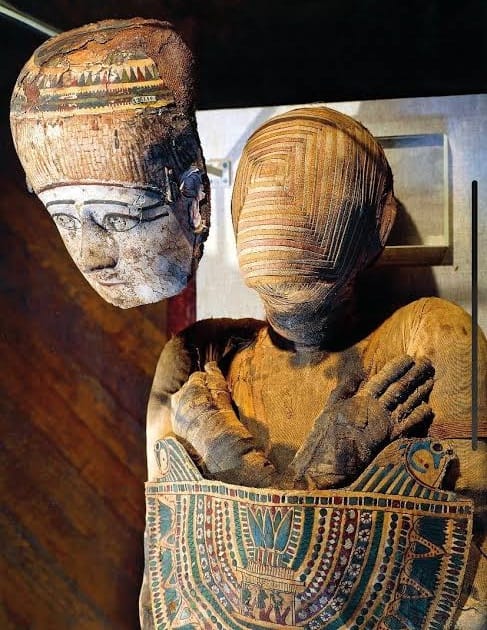
•The mummification process according to the Greek historian Herodotus :
•First the removal of the brain and viscera.
Then these internal organs were mummified separately and placed in canopic jars.
•The body cavity was cleaned with palm oil and filled with crushed myrrh and various aromatics.
•The body was then covered with natron, generally for 70 days, to speed up the dehydration process.
•At the end of this process, the mummy was wrapped in strips of linen that had been dipped in resin; throughout this step, priests placed many protective amulets among the wrappings.
•This extremely well-preserved mummy in the pictures is that of a man who lived during the Ptolemaic Period (305 BC_ 30 BC) and is now displayed in the Louvre museum.
•The mummy is covered with a cartonnage consisting of several elements: a mask covering the head, a wide collar over the chest, an apron across the legs, and finally, a casing over the feet.

Here is a wonderfully well-preserved Mummy of a Man from the Ptolemaic period of Egypt. (from 305 to 30 BC).
Although much of the mummification process is now known there remains an air of mystery around the overall concept, along with some of the finer details.
The sophisticated woven pattern around the mummies face is in itself a thing of beauty and intrigue.
In the image, we can see the preserved Man’s body has been placed in the well-known position with the arms crossed at the chest centre.
This position often denotes that the individual is Male. However, the symbolism of the form itself may have far deeper meaning.
The arms are crossed at the chest centre, the Heart centre, where the Thymus Gland and Heart are located.
Egyptian culture held the Heart in the highest regard, and with the greatest veneration.
While the wrists are crossed at the Heart centre we can see that the hands themselves lay comfortably at the edge of the pectoral muscles, just outside of the armpit.
This is mentioned because the natural placement of the hands and fingertips, whilst in this position, lay at the location of very important pressure points within the Human body.
In the Vedic tradition, the Sanskrit name for these points is Kakshadhara.
These are Marma points within the channel system of the Nadis. (Energy centres within energy channels).
In the far East this general area has a number of acupoints –
In the Lung meridian (energy channel) there are the “middle palace” and “cloud gate” points.
Both of these locations help with lung and breathing problems, when accessed correctly.
There are also energy centres belonging to the stomach channel in this area –
“The Qi door” and “the storehouse” are the ancient names of these energetic pressure points.
The energy centres and energy channels of the Human body have been worked with and fine tuned for a long time.

